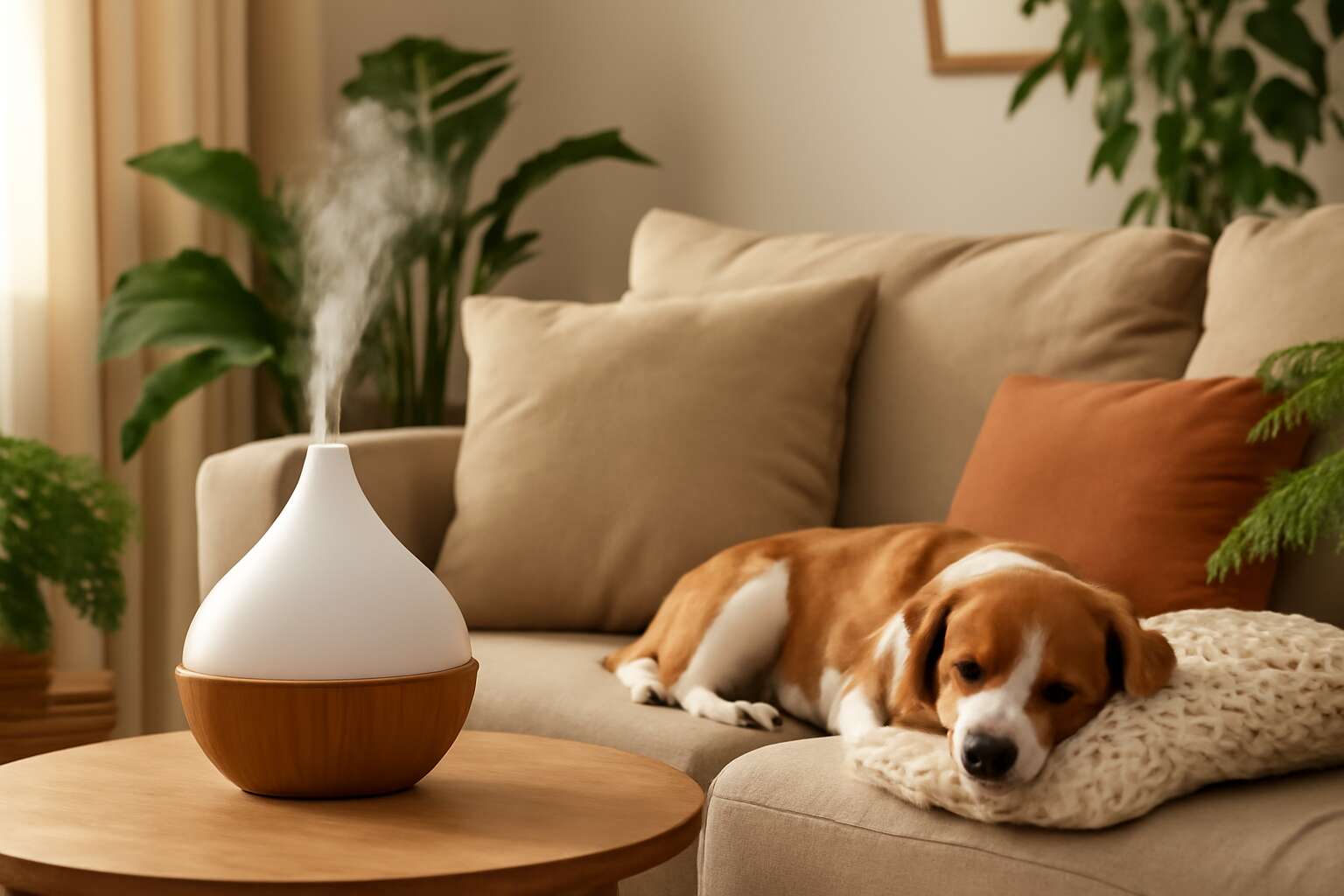Understanding Aromatherapy Diffusers and Their Purpose
What Are Aromatherapy Diffusers?
Imagine a device that transforms a handful of essential oils into a fragrant mist, turning your living space into a zen-like sanctuary. That’s the magic of an aromatherapy diffuser, designed to disperse natural scents evenly throughout your home. But as pet parents, the question lingers—are aromatherapy diffusers safe for dogs? It’s a valid concern, especially since our furry friends are often more sensitive to airborne substances than we are.
Understanding aromatherapy diffusers and their purpose is crucial. These nifty gadgets come in various forms—ultrasonic, nebulizing, heat-based—and serve to release essential oils into the air, promoting relaxation, better sleep, or even a sense of calm during stormy weather. However, not all diffusers are created equal, and some may pose risks for dogs if used improperly. It’s essential to know what makes a diffuser safe or unsafe for your four-legged companion, especially considering that dogs can experience adverse reactions to certain essential oils.
- Ultrasonic diffusers, for example, work quietly and are popular for their gentle mist, but the type of essential oils used can make all the difference in safety for dogs.
- Choosing high-quality, vet-approved essential oils and ensuring proper ventilation can significantly reduce potential health risks.
Common Types of Diffusers
Understanding aromatherapy diffusers and their purpose reveals a delicate balance between wellness and caution, especially for our beloved pets. These devices quietly transform essential oils into a soothing mist, filling homes with calming scents that can ease anxiety, promote restful sleep, and elevate the ambiance of any space. But the question lingers—are aromatherapy diffusers safe for dogs? It’s a query rooted in genuine concern, as the airborne nature of these devices can sometimes harbor risks.
Common types of diffusers include ultrasonic, nebulizing, and heat-based models. Each operates differently, yet their impact on dogs depends heavily on the essential oils employed and the environment in which they are used. For instance, ultrasonic diffusers work softly and efficiently, dispersing a fine mist of oils that can linger in the air. The safety hinges on choosing high-quality, vet-approved essential oils and ensuring proper ventilation. After all, dogs are more sensitive to airborne substances than humans, and a small oversight can lead to adverse reactions.
How Do Aromatherapy Diffusers Work?
Understanding how aromatherapy diffusers work reveals a fascinating blend of science and artistry. These devices transform liquid essential oils into an invisible, fragrant mist that gently disperses into the air, creating an environment of calm and serenity. Unlike candles or sprays, diffusers provide a steady, controlled release of scents, making them a popular choice for those seeking natural wellness solutions. But, amid the calming allure, a question lingers—are aromatherapy diffusers safe for dogs? This concern arises because the gentle mist, though seemingly harmless, can sometimes carry airborne particles that impact our furry friends.
Most aromatherapy diffusers operate through one of three main methods: ultrasonic, nebulizing, or heat-based technology. Ultrasonic diffusers, for example, use vibrations to break down essential oils into tiny particles, producing a fine mist that lingers in the air. Their quiet operation and efficient dispersion make them a favorite in homes. However, the safety of these devices for dogs depends largely on the types of essential oils used and proper ventilation. When choosing oils, it’s crucial to opt for vet-approved and pet-safe options, as some scents can trigger sensitivities or adverse reactions in dogs.
Potential Risks of Aromatherapy Diffusers for Dogs
Essential Oils Used in Diffusers
Amidst the shadows of serenity, a lurking question persists—are aromatherapy diffusers safe for dogs? The ethereal allure of essential oils masks a darker truth: not all scents are kindred spirits to our canine companions. Some oils, when dispersed into the air, can seep into their delicate respiratory systems, igniting a cascade of adverse reactions. Caution is paramount, for the line between healing and harm is as thin as a whisper in the dark.
Many essential oils used in diffusers possess properties that can be toxic to dogs—think of tea tree, eucalyptus, or citrus oils—each carrying the potential to cause symptoms such as drooling, vomiting, or difficulty breathing. If you are pondering whether your diffuser’s aromatic embrace is safe, consider the ingredients carefully. Remember, what soothes your senses might threaten your loyal friend’s well-being. A vigilant approach ensures that the tranquil glow of aromatherapy does not turn into a sinister shadow lurking in your home.
Toxicity of Certain Oils to Dogs
While the gentle hum of an aromatherapy diffuser can create a peaceful sanctuary in your home, a startling truth lurks beneath the surface—are aromatherapy diffusers safe for dogs? Many pet owners are unaware that certain essential oils commonly used in diffusers pose serious health risks to their furry friends. Dogs have a more sensitive respiratory system than humans, making them vulnerable to even small amounts of airborne toxins.
Some essential oils, such as tea tree, eucalyptus, and citrus, are notorious for their toxicity to dogs. Exposure to these oils through diffusers can lead to symptoms like drooling, coughing, vomiting, or even difficulty breathing. The danger is particularly acute because the oils are dispersed into the air, making it easy for pets to inhale them unknowingly. It’s vital to understand that not all oils are safe, and what might be soothing to a human could be harmful to a dog.
- Tea tree oil
- Eucalyptus oil
- Citrus oils
These oils can cause adverse reactions even in small quantities, so pet owners must exercise caution. If you’re wondering, “are aromatherapy diffusers safe for dogs,” it’s best to consult with a veterinarian before using any essential oils in your diffuser. The tranquility you seek should not come at the expense of your loyal companion’s health and happiness.
Health Risks for Dogs from Diffuser Use
The gentle whisper of an aromatherapy diffuser can transform a home into a sanctuary of serenity, yet beneath its calming façade lurks a potential threat to our loyal companions. The question, “are aromatherapy diffusers safe for dogs,” echoes with urgency for pet owners who cherish their furry friends. Dogs, with their delicate respiratory systems, are far more vulnerable to airborne toxins than humans.
When essential oils such as tea tree, eucalyptus, or citrus are dispersed into the air, they can unleash a silent storm within a dog’s body. Symptoms like excessive drooling, coughing, or labored breathing may appear suddenly, revealing the peril that lurks unseen. The risk magnifies with even minimal exposure—what soothes a human may distress a dog profoundly.
In truth, the danger is not merely hypothetical. It’s a visceral reality that pet owners must acknowledge. The allure of a fragrant home must never eclipse the health and happiness of our canine companions.
Safe Practices When Using Aromatherapy Diffusers Around Dogs
Choosing Dog-Safe Essential Oils
When contemplating the question, “are aromatherapy diffusers safe for dogs,” one must consider the delicate balance between wellness and harm. Essential oils are potent, and their effects on our furry companions are often underestimated. The key lies in understanding that not all oils are created equal, and some can be subtly toxic to dogs even in small amounts. The aroma may seem harmless, yet it can trigger adverse reactions, from respiratory distress to behavioral changes.
To navigate this landscape responsibly, prioritize choosing dog-safe essential oils. These oils have been studied and tested for safety around canines, reducing the risk of unwanted health consequences. When using an aromatherapy diffuser, ensure proper ventilation and never leave the device unattended for extended periods.
A simple rule of thumb is to opt for oils that are known to be non-toxic to dogs, such as lavender or chamomile. Always remember, the question remains—are aromatherapy diffusers safe for dogs? The answer hinges on informed choices and cautious application.
Proper Ventilation and Diffuser Placement
In the shadowed corners of wellness, where scent and serenity intertwine, lies a question that whispers with caution: are aromatherapy diffusers safe for dogs? The answer is shrouded in nuance—an intricate dance between the allure of calming aromas and the silent threat they may pose. Proper ventilation becomes the guardian of this delicate balance, a vital safeguard against the unseen perils lurking within the fragrant mist.
When employing an aromatherapy diffuser around your loyal companion, consider the placement as if you were positioning a sentinel. Keep it out of reach of curious noses and paws, ideally in a well-ventilated space where the air can circulate freely—diluting the potency and reducing the risk of adverse reactions. To further diminish danger, opt for discreet locations that prevent direct inhalation yet allow the aroma to gently diffuse into the environment. Remember, the goal is harmony, not harm—never leave the diffuser unattended for long stretches, especially when first introducing it into your home. Safety isn’t just a precaution; it’s an act of devotion, woven into the very essence of caring for your furry friend.
Monitoring Your Dog’s Reaction
Watching over your furry friend while indulging in aromatic bliss requires vigilance and tenderness. When using an aromatherapy diffuser around dogs, it’s essential to monitor their reaction closely. Every dog’s response to essential oils can vary — what calms one might irritate another. Observe signs such as sneezing, coughing, drooling, or signs of distress, which could signal an adverse reaction. Remember, subtle cues often reveal more than words ever could.
To ensure safety, consider establishing a “watchful eye” during initial diffuser use. Keep a mental note of any behavioral changes, and if symptoms appear, promptly turn off the diffuser and consult a veterinarian. The importance of this attentive approach cannot be overstated—safety isn’t just about placement, but ongoing observation. For peace of mind, you might even keep a journal of your pet’s responses, helping you discern whether the calming scents are truly beneficial or potentially harmful.
- Stay vigilant for any unusual behavior.
- Limit diffuser exposure initially, gradually increasing if no adverse reactions occur.
- Always consult a veterinarian if unsure about specific essential oils or your dog’s reaction.
By adopting these safe practices, you create a harmonious environment that respects the delicate balance between serenity and safety. After all, the goal is to bring tranquility without risking your dog’s well-being — a dance that demands both intuition and care. Are aromatherapy diffusers safe for dogs? With mindfulness and attentive observation, they can be a gentle addition to your home’s wellness ritual.
Signs That Your Dog May Be Suffering from Aromatherapy Exposure
Behavioral Changes to Watch For
While many pet owners believe that aromatherapy diffusers are a gentle way to create a calming environment, the reality can be far more complex. Dogs are highly sensitive to their surroundings, and subtle changes in their behavior can signal discomfort or distress. Recognizing the signs that your dog may be suffering from aromatherapy exposure is crucial, especially since the question remains: are aromatherapy diffusers safe for dogs?
Behavioral changes often serve as the first indicators of adverse reactions. Watch for symptoms such as excessive drooling, panting, or restlessness. Some dogs may become unusually withdrawn or show signs of irritability. In more severe cases, you might notice coughing, sneezing, or difficulty breathing. These symptoms suggest that exposure to certain essential oils via a diffuser could be affecting your canine companion.
- Unusual vocalizations or whining
- Loss of appetite or lethargy
- Scratching or rubbing at the face or nose
If these signs are observed, it is essential to evaluate the diffuser’s placement and the specific oils used. Understanding the risks associated with aromatherapy diffusers and dogs can help prevent potential health crises and ensure your furry friend remains safe and comfortable.
Physical Symptoms
Signs that your dog may be suffering from aromatherapy exposure can appear suddenly and escalate quickly. Physical symptoms are often the first indicators that something isn’t right. Excessive drooling, persistent coughing, or sneezing may suggest irritation or respiratory distress. Watch for symptoms like labored breathing or wheezing—these are more serious and require immediate attention.
Other subtle signs include lethargy, loss of appetite, or unusual vocalizations such as whining or yelping. Dogs may also scratch or rub their face and nose more than usual, trying to relieve discomfort. These behaviors can signal that the essential oils in the diffuser are affecting their sensitive respiratory systems. Recognising these signs early can prevent a potential health crisis, especially since many pet owners wonder: are aromatherapy diffusers safe for dogs? Being aware of physical symptoms helps you assess whether your diffuser setup is safe or if it needs adjustment.
When to Seek Veterinary Care
When it comes to the question of whether aromatherapy diffusers are safe for dogs, vigilance is paramount. Dogs are remarkably perceptive creatures, but their sensitivity to essential oils can turn from subtle to severe in a heartbeat. Recognising the signs that your dog may be suffering from aromatherapy exposure is essential for every pet owner who values both wellness and safety.
Physical symptoms often serve as the first alarm bells—excessive drooling, coughing, or sneezing are common early indicators of irritation. More alarming are labored breathing or wheezing, which demand immediate veterinary attention. Sometimes, subtle behavioral shifts such as lethargy, loss of appetite, or unusual vocalizations like whining may also hint at distress. If your dog is scratching or rubbing their face or nose more than usual, it might be a sign that the essential oils in the diffuser are affecting their delicate respiratory systems.
It’s crucial to act swiftly. If these signs are observed, consulting a veterinarian without delay can prevent a minor issue from escalating into a serious health crisis. Remember, knowing whether aromatherapy diffusers are safe for dogs isn’t just a matter of curiosity but a vital component of responsible pet ownership. When in doubt, always prioritize your canine companion’s health and safety.
Expert Opinions and Recommendations
Veterinary Advice on Aromatherapy for Pets
Veterinary experts approach aromatherapy for pets with a mixture of curiosity and caution, emphasizing that safety hinges on careful selection and vigilant observation. While some professionals acknowledge the potential benefits of certain essential oils, they strongly advise that pet owners ask, are aromatherapy diffusers safe for dogs before introducing such products into their homes. The American Veterinary Medical Association (AVMA) underscores that many oils can be toxic, and even seemingly benign blends may cause adverse reactions in sensitive animals.
According to veterinary advice, the best course of action is to consult with a trusted veterinarian before using aromatherapy diffusers around dogs. They often recommend an individualized approach, considering the dog’s breed, health status, and behavior. Some vets suggest that if aromatherapy is to be used, it should be done in a well-ventilated area, and only with pet-safe essential oils. Monitoring your dog’s physical and behavioral responses after diffuser use can be crucial in ensuring the ongoing safety of your furry friend.
Guidelines From Pet Safety Organizations
When it comes to safeguarding our canine companions, expert opinions echo a cautious refrain: the question of whether aromatherapy diffusers are safe for dogs remains a topic of ongoing scrutiny. Pet safety organizations emphasize that while aromatherapy can seem like a gentle enhancement to home wellness routines, the potential risks are far from negligible. The American Veterinary Medical Association (AVMA) urges pet owners to approach with vigilance, highlighting that many essential oils used in diffusers can pose serious health hazards to dogs.
Guidelines from reputable pet safety organizations recommend strict adherence to these principles:
- Always consult a licensed veterinarian before introducing an aromatherapy diffuser into a household with dogs.
- Use only pet-safe essential oils, specifically formulated for canine health.
- Ensure the diffuser is placed in a well-ventilated area, away from your dog’s usual resting spots.
Monitoring your dog’s reaction after diffuser use can reveal subtle signs of distress or discomfort, which are crucial indicators of potential toxicity. The consensus among experts is clear: understanding the delicate balance between aromatherapy’s benefits and its risks is essential to truly answer the question, are aromatherapy diffusers safe for dogs? Only through informed, cautious use can pet owners hope to harness the calming effects without compromising their furry friend’s safety and well-being.
Consulting a Pet-Care Professional
When considering the delicate intersection of holistic wellness and canine safety, expert opinions serve as a vital compass. Many pet-care professionals caution that the question “are aromatherapy diffusers safe for dogs?” isn’t easily answered with a simple yes or no. Instead, it demands careful consultation with veterinary experts who possess an intimate understanding of canine physiology and the potential effects of essential oils. Veterinarians often emphasize that only pet-safe essential oils should be used, and that professional guidance is crucial before introducing any diffuser into a dog-friendly environment.
Reputable pet health organizations recommend a cautious approach, highlighting that even natural-sounding remedies can carry inherent risks. Consulting a trusted pet-care professional provides clarity, ensuring pet owners are aware of the subtle signs of distress that might otherwise go unnoticed. To navigate this complex landscape, consider these recommendations:
- Always seek veterinary advice before using an aromatherapy diffuser around dogs.
- Use only essential oils formulated specifically for canine health and safety.
- Monitor your pet’s behavior diligently after diffuser use to catch any early signs of discomfort.
By engaging with a professional, pet owners can better understand the nuanced effects of aromatherapy on their furry friends. It’s a partnership rooted in knowledge, compassion, and respect for the delicate balance between wellness and safety. For those pondering the question, “are aromatherapy diffusers safe for dogs?” expert guidance remains the most reliable pathway to peace of mind and optimal pet health. After all, safeguarding our dogs isn’t just about avoiding harm; it’s about nurturing their well-being with informed, conscientious choices.
Alternatives to Diffusers for Dog Aromatherapy
Using Diluted Essential Oils Safely
For those who cherish the calming influence of essential oils on their pets, a question often arises: are aromatherapy diffusers safe for dogs? While diffusers can fill a space with soothing scents, they aren’t the only way to introduce aromatherapy into a dog-friendly environment. Alternative methods allow for the benefits of essential oils without the potential risks associated with traditional diffusers.
One gentle approach is to dilute essential oils strongly and apply them topically in small, targeted areas, such as behind the ears or on paw pads. This method minimizes airborne exposure and offers a controlled way to deliver the oils’ therapeutic properties. Additionally, you might consider creating a personal aromatherapy spritz with a safe essential oil blend, sprayed onto fabrics or bedding far from your pet’s reach.
Here are some safer alternatives to diffusing essential oils around dogs:
- Using essential oils in a diffuser only in well-ventilated areas, away from your pet’s usual hangouts.
- Applying diluted oils in small amounts directly onto your dog’s collar or harness, avoiding the air entirely.
- Opting for aromatherapy products specifically formulated for pets, which are often tested for safety and efficacy.
Each of these options can help harness the benefits of aromatherapy while prioritizing your dog’s health, especially when you’re wondering are aromatherapy diffusers safe for dogs. Remember, always consult a veterinarian or pet aromatherapy expert before introducing new scents into your pet’s environment.
Other Aromatherapy Methods
When pondering whether aromatherapy diffusers are safe for dogs, it’s comforting to know there are several alternative methods to enjoy the soothing scents without risking Fido’s health. For pet owners concerned about the potential dangers, these options provide a safer, more controlled approach to aromatherapy.
One effective method is to apply diluted essential oils directly onto your dog’s collar or harness. This keeps the scent close without filling the air, reducing the risk of airborne exposure. Additionally, creating a personal aromatherapy spritz—think of it as your pet-safe perfume—allows you to spray a gentle blend onto fabrics or bedding, far from your pet’s nose. This way, your furry friend can enjoy the benefits without the scent lingering in the environment.
- Use essential oils in a diffuser only in well-ventilated areas, ensuring your dog’s usual hangouts remain free of concentrated vapors.
- Opt for pet-specific aromatherapy products, specially formulated and tested to be safe for animals, rather than generic diffusers that might pose risks.
Exploring these alternatives helps to answer the question: are aromatherapy diffusers safe for dogs? The key is moderation and proper safety measures—because when it comes to our pets’ well-being, a cautious approach is always best. And remember, before introducing any new scent into your dog’s environment, a quick chat with a veterinarian or pet aromatherapy expert is always a smart move.
DIY Pet-Safe Aromatherapy Options
When considering whether aromatherapy diffusers are safe for dogs, many pet owners seek gentler, more personal alternatives that maintain the soothing essence of aromatherapy without risking Fido’s health. DIY pet-safe aromatherapy options can transform your home into a sanctuary of calm, without the overwhelming presence of concentrated vapors.
One delightful approach is to create a custom aromatherapy spritz—think of it as your pet-safe perfume—by blending diluted essential oils and spritzing them onto fabrics or bedding away from your dog’s nose. This technique allows your furry friend to enjoy the benefits of calming scents without the potential hazards of diffusion. For added safety, consider applying diluted essential oils directly onto your dog’s collar or harness, ensuring the scent stays close without filling the air with vapors.
For those who prefer a more structured method, using pet-specific aromatherapy products is highly recommended. These formulations are specially tested for safety and designed with your pet’s delicate physiology in mind. When exploring these alternatives, always prioritize moderation and thorough ventilation, and consult with a veterinarian to ensure the choices align with your dog’s unique needs. Ultimately, understanding whether aromatherapy diffusers are safe for dogs invites pet owners to embrace safer, more mindful ways to infuse their surroundings with calming, natural scents.




0 Comments